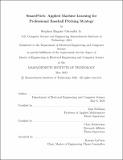SmartPitch: Applied Machine Learning for Professional Baseball Pitching Strategy
Author(s)
Otremba Jr., Stephen Eugene
DownloadThesis PDF (15.50Mb)
Advisor
Edelman, Alan
Rackauckas, Chris
Terms of use
Metadata
Show full item recordAbstract
The stateful nature of baseball has made it a prime candidate for exploring the topics of planning and strategy optimization. Nearly every moment of the game - from the first pitch to the final out - can be described by a collection of well known state variables that even casual fans should be familiar with. Markov Decision Processes and dynamic programming techniques have previously been applied to this space in order to research the areas of offensive player selection (lineup creation) and player substitution, but they have rarely been studied in the context of one of the most complicated parts of the sport: the minigame between the pitcher and the batter. Even this component of the sport is dictated by a progression of states, as the battle between a pitcher and batter is often tracked using a simple tuple of information known as the count, which captures the number of balls and strikes the pitcher has thrown. Using the count, we’re able to directly map the states of this pitcher-batter match-up to a Markov Decision Process, with state-transition probabilities estimated from supervised machine learning models trained on publicly released data collected through Major League Baseball’s statistics arm. In this thesis, we will discuss how this model of baseball can be used to evaluate optimal pitching strategies that can exploit the tendencies of specific batters and leverage a pitcher’s arsenal of available actions to minimize offensive production. We will explore the application of well-known reinforcement learning algorithms to calculate these pitching policies and will analyze the effectiveness of dimensionality reduction and artificial neural networks in estimating the components needed to construct our Markovian model of baseball.
Date issued
2022-05Department
Massachusetts Institute of Technology. Department of Electrical Engineering and Computer SciencePublisher
Massachusetts Institute of Technology